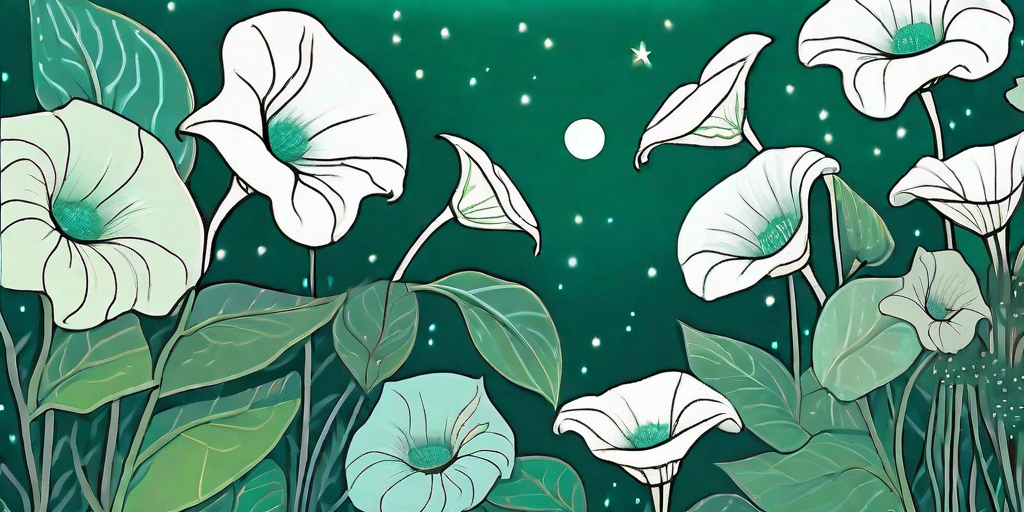
As the sun dips below the horizon and the stars begin to twinkle, imagine your garden coming alive with the glow of moonflowers. These celestial beauties, with their large, fragrant blooms, can turn any ordinary garden into a magical, moonlit oasis. But how exactly can you achieve this enchanting transformation? Well, dear reader, grab your gardening gloves and prepare to get your hands dirty, because we're about to embark on a horticultural journey to the stars.
Understanding the Magic: What are Moonflowers?
Before we dive into the nitty-gritty of moonflower cultivation, let's take a moment to appreciate these nocturnal wonders. Moonflowers, or Ipomoea alba, are a type of flowering vine that bloom in the evening and stay open until the sun rises. With their large, white, trumpet-shaped flowers and heart-shaped leaves, they're a sight to behold in any garden.
But moonflowers aren't just pretty faces. They're also known for their intoxicating fragrance, which is most potent at night. This scent, along with their luminous white blooms, attracts night-flying pollinators like moths. So, by planting moonflowers, you're not only beautifying your garden, but also supporting your local ecosystem. Now, isn't that a win-win?
The Star of the Show: How to Plant Moonflower Seeds
Step 1: Choosing Your Seeds
Like any great adventure, planting moonflowers starts with a choice. You can either purchase moonflower seeds from a local nursery or online, or you can harvest them from an existing moonflower plant. If you're going for the latter, just remember to wait until the seed pods have dried out before collecting the seeds.
Once you have your seeds, it's time to prepare them for planting. Moonflower seeds have a hard outer shell, so they need a bit of help to germinate. You can do this by soaking the seeds in water for 24 hours, or by nicking the seed coat with a knife or nail file. Just be careful not to damage the inner part of the seed.
Step 2: Finding the Perfect Spot
Moonflowers are sun worshippers by day and moon gazers by night. They need a spot in your garden that gets plenty of sunlight during the day, but is also visible from your favourite moon-viewing spot. After all, what's the point of planting moonflowers if you can't enjoy their nocturnal beauty?
These plants also need something to climb on, like a trellis, fence, or even another plant. So, make sure to take this into account when choosing your planting spot.
Step 3: Planting the Seeds
Now that you've chosen your seeds and found the perfect spot, it's time to get planting. Dig a hole about a quarter of an inch deep, place your seed in the hole, and cover it with soil. Then, water the area thoroughly. After that, all you need to do is wait for your seeds to sprout, which usually takes about two weeks.
Once your moonflowers start growing, make sure to provide them with plenty of water and fertilizer. These plants are heavy feeders, so they need all the nutrients they can get to produce their spectacular blooms.
Extra Twinkle: Caring for Your Moonflowers
Planting moonflowers is just the beginning. To keep your garden looking like a celestial oasis, you need to take good care of your plants. This includes regular watering, fertilizing, and pruning.
Moonflowers are relatively easy to care for, but they do have their quirks. For example, they're prone to pests like aphids and spider mites, so keep an eye out for these little troublemakers. If you spot any, you can usually get rid of them with a blast of water or a natural insecticide.
FAQs: Your Moonflower Queries Answered
Can I grow moonflowers in a pot?
Absolutely! Moonflowers can thrive in pots, as long as they have enough room to grow and something to climb on. Just make sure to use a pot with good drainage to prevent waterlogging.
Are moonflowers poisonous?
While moonflowers are a feast for the eyes, they're not so great for the stomach. All parts of the plant are toxic if ingested, so keep them out of reach of children and pets.
When is the best time to plant moonflower seeds?
The best time to plant moonflower seeds is in the spring, after the last frost. However, if you live in a warmer climate, you can plant them any time of the year.
Conclusion: The Magic of Moonflowers
Planting moonflowers is like sprinkling a bit of stardust in your garden. With their luminous blooms and enchanting fragrance, these plants can transform any outdoor space into a magical, moonlit oasis. So, why not give it a try? With a bit of care and patience, you too can cultivate your own celestial garden. And who knows? You might just find that gardening by moonlight is your new favourite hobby.















